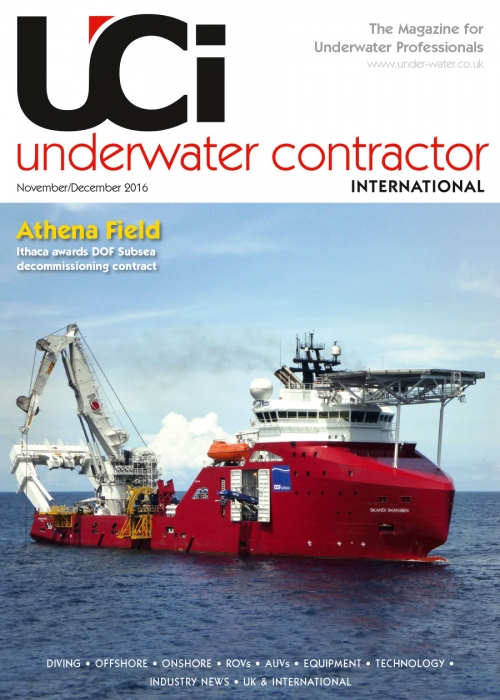
The Magazine for Underwater Professionals
![]() Jan/Feb 2016
Jan/Feb 2016
INDUSTRY NEWS - SUPPORT VESSELS
IHC launches pipelay vessel for Subsea 7
Royal IHC, the Netherlands, has named and launched the 550-tonne top tension capacity pipelay vessel Seven Cruzeiro at its shipyard in Krimpen aan den IJssel. This is the final pipelaying vessel in a series of three ordered by Subsea 7.
The dynamically positioned pipelay vessel is capable of operating in water depths of up to 3000 metres and is suitable for operations worldwide. Designed by IHC in close collaboration with Subsea 7, the vessel is fitted with two under-deck storage carousels with a capacity for 2500 tonnes and 1500 tonnes of product respectively.
A vertical (tiltable) lay system with a 550-tonne top tension capacity is permanently installed for the deployment of a range of flexible products with a diameter of 50 to 650 millimetres. The lay tower can operate at up to ten degrees from the vertical and is fitted with two wire centralisers and with two tensioners, each with a 275-tonne capacity, that can be retracted clear of the firing line. The pipelaying systems are delivered by Huisman, the Netherlands.
“Over the years we have worked closely together with Subsea 7 on a total of eight vessels,” said Arjan Klijnsoon, IHC’s executive director of shipbuilding. “IHC is proud of its long-standing relationship with Subsea 7 and the confidence they have in our ability to deliver high-quality vessels on time.”
USA-based Bordelon Marine reports it has taken delivery of the Brandon Bordelon, a DP2 ultra-light intervention vessel (ULIV).
“This highly specialised vessel features a helideck, a 60-tonne AHC crane with 3000-metre of wire and a mezzanine deck with internal office and control rooms capable of supporting two full work-class ROV systems. The vessel also offers 6200 square-feet (576 square-metres) of clear useable deck space,” said the company.
The firm added that the Brandon Bordelon comes equipped with two Ranger2 Pro thru-hull USBL full systems. “The vessel delivers a fully integrated ROV control room, ROV support offices, below deck work and storage spaces, extensive communications and ROV data network, plug and play, with patch panel racks installed, all tied into the vessel systems, bridge, office and accommodation spaces,” said Bordelon.
Marin Teknikk, Norway, has entered into a contract for the design and engineering of two diving support and construction vessels for Ultra Deep Offshore in Singapore. The vessels are a newly developed MT6023 DSCV design and will be equipped with an 18-man diving system for operations down to 300 metres water depth.
MT6023 DSCV is an advanced diving and construction vessel developed for demanding operations worldwide, according to Marin. The vessel will have a length of 103 metres and a breadth of 23 metres, accommodation for 120 crew plus 18 divers, two heave compensated subsea cranes, one 150-tonne offshore crane with a depth capability to 3000 metres and one 20-tonne offshore crane for operation down to 300 metres. In addition, there will be an arrangement for two work-class ROVs for operation down to 3000 metres.
The vessels are to be built by Wuchang Shipbuilding Industry Group in China, where the first vessel is planned to be delivered mid-2018 and second vessel at the end of 2018.
“We are very pleased to sign this contract, especially when we see the weak market within the oil and gas industry,” said Svein-Rune Gjerde, chief executive officer at Marin Teknikk. “We have been working close with Ultra Deep Offshore the last three years to develop several advanced diving vessels. With this new contract shows again Marin Teknikk’s strong position in the OSV market and that we are among the world’s leading designers of advanced diving and construction vessels.”
British Antarctic Survey (BAS) has declared its third option for a one-year extension of the bareboat charter for RRS Ernest Shackleton. The option will be effective from August 2016.
RRS Ernest Shackleton has been on a long-term charter with BAS since August 1999. BAS holds two more annual options to extend the bareboat charter.
The polar research and subsea support vessel was launched in 1995 as MV Polar Queen for GC Rieber Shipping, Norway, and was operated in the Antarctic by other national programmes. When BAS acquired the vessel on a long-term bareboat charter in 1999 she was renamed RRS Ernest Shackleton after the British polar explorer Sir Ernest Shackleton.
The vessel is ice strengthened and capable of a wide range of logistic tasks as well as having scientific capabilities.


